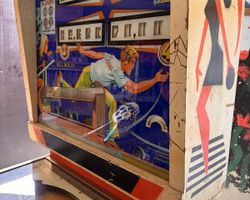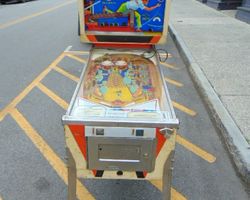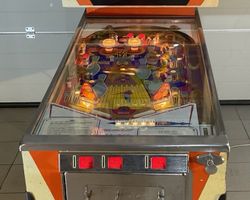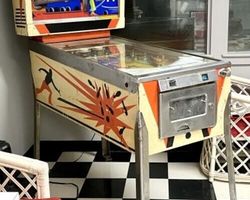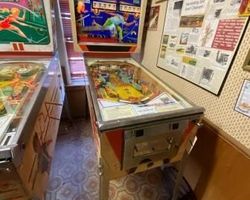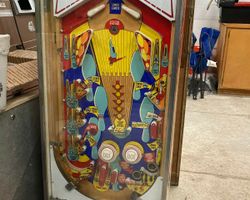"300"
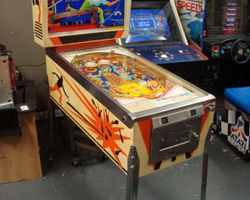
Average Prices: USD $300 to $1,000
Produced: August, 1975
Production Run: 7,925 units
Machine Type: Electro-mechanical
Players: 4
Design by: Ed Krynski
Art by: Gordon Morison
The pinball machine "300," manufactured by D. Gottlieb & Co., represents a distinctive entry in the pantheon of electro-mechanical (EM) games from the mid-1970s. Released in August 1975, this four-player machine, model number 388, captured the essence of the bowling theme, a popular subject for pinball at the time. With a confirmed production run of 8,157 units, including 232 sample games, "300" became a notable presence in arcades and amusement locations.
The design of "300" was a collaborative effort, with Ed Krynski credited for the machine's design and backbox animation, alongside Wayne Neyens, who contributed to the design, concept, and animation. The vibrant artwork, a hallmark of Gottlieb machines from this era, was rendered by Gordon Morison, bringing the bowling alley aesthetic to life on the playfield and backglass. The inspiration for "300" clearly stemmed from the pursuit of a perfect game in bowling, the titular score representing the pinnacle of achievement. Interestingly, Gottlieb also produced a two-player version of this machine in 1975, titled "Top Score," sharing an identical playfield and rule set, differing only in player capacity. Upon its release, "300" was offered to operators at a price of $1095 FOB Chicago, reflecting its positioning as a full-featured EM offering.
Distinctive Features and Visual Appeal
"300" distinguishes itself through several unique elements that contribute to its gameplay and visual identity. The most recognized feature is its mechanical backbox animation, dubbed "Bowling Balls Added." As players achieve specific objectives on the playfield, small bowling balls physically ascend a ramp within the backbox, appearing to accumulate. This visual and auditory spectacle, characterized by a satisfying "ka-chunk, ka-chunk" sound as each ball registers, is central to the machine's charm and bonus progression. This mechanical ingenuity enhanced the feedback loop for players, visually reinforcing their progress.
Beyond the backbox, the playfield boasts a prominent spinning target, often described as a "rip the spinner" shot. Striking this target repeatedly with the ball generates high scores and provides a tactile and auditory thrill. The machine also incorporated a right outlane ball return gate, a thoughtful feature designed to offer players a second chance and mitigate frustrating drains, a common challenge on many EM machines. A half-moon credit window adds to the classic EM aesthetic, complementing the mechanical scoring reels. These features, combined with the end-of-ball bonus system, enhance the overall engagement, ensuring that every ball played feels consequential.
Playfield Layout and Mechanical Interaction
The "300" playfield presents an asymmetric layout, offering a variety of shots and challenges. While some layouts from the era adhered to strict symmetry, "300" embraced an uneven design that proved effective in gameplay. The two flippers provide primary control, positioned to allow for aiming at key targets across the playfield. Two pop bumpers animate the upper playfield, deflecting the ball unpredictably and creating rapid scoring opportunities. Flanking the lower flippers are two slingshots, which propel the ball with force, adding to the dynamic movement.
Four standup targets are strategically placed, requiring precise shots to light features or score points. Two kick-out holes add a layer of interaction; these novel mechanisms eject the ball after it falls into them, often leading to bonus accumulation or specific objectives. The central spinning target, a focal point, invites players to hit it repeatedly for high scores. A star rollover and two parallel lanes of serial rollovers, referred to in the manufacturer's flyer as the "Tantalizing Pin Ball Lane," guide the ball towards bonus accumulation, rewarding skilled nudging and shot placement.
The right side of the playfield houses a distinctive cluster of mini lanes, sometimes likened to a bagatelle section. Navigating these lanes requires a deft touch and often precise nudging to light the associated rollovers and earn points. While some players find this area challenging and a potential drain risk, others appreciate the skill required to master it. Gordon Morison's artwork on the playfield is characterized by bright colors and classic EM styling, featuring bowling pins, balls, and lanes that reinforce the machine's theme. While opinions on the art vary, it generally contributes to a cohesive visual experience, complemented by the machine's lighting, which illuminates key targets and bonus progress.
Unpacking Gameplay Dynamics
The gameplay of "300" is direct and engaging, adhering to the straightforward rules common to EM machines while incorporating a unique scoring spectacle. The primary objective revolves around building an end-of-ball bonus, visually represented by the "Bowling Balls Added" animation in the backbox. Each time a player fulfills specific conditions, another ball is added to the bonus count. As the ball drains, the accumulated bonus points are tallied, accompanied by the distinctive "ka-chunk, ka-chunk" sounds and mechanical reels spinning, creating a highly satisfying conclusion to each ball. In multi-ball play, a bonus multiplier for successive balls amplifies the engagement, encouraging players to maximize their bonus potential.
The central spinner is a core gameplay element, rewarding sustained hits with significant points. Mastering the "rip the spinner" technique is crucial for high scores. Another key strategic element involves navigating the parallel rollover lanes and the cluster of mini lanes on the right. These areas demand precise aiming and judicious nudging to light the required rollovers, contributing to bonus accumulation and score.
A standout challenge within "300" is the "Special" or "Collect Bonus" kick-out hole. This shot is widely recognized for its extreme difficulty, often requiring precise nudging and timing to achieve. Successfully hitting this target yields a significant reward, adding an element of high-risk, high-reward strategy to the game. While some find its difficulty frustrating, others appreciate it as a high-skill objective that adds replayability for experienced players. The interplay between accumulating bonus, ripping the spinner, and attempting the elusive special shot forms the core gameplay loop. While some might find the objectives somewhat repetitive over extended play sessions due to the singular focus on point accumulation, the inherent fun of the mechanics and the satisfying bonus sequence ensure sustained engagement.
Reception and Enduring Legacy
"300" has garnered a largely positive reception within the pinball community, consistently praised as an enjoyable and addictive electro-mechanical game. Its strengths are frequently highlighted: the unique and satisfying mechanical backbox animation, the classic chime and bell sounds characteristic of Gottlieb EM machines, and the engaging spinner shot. Players often commend its balance of skill and chance, making it accessible to casual players while offering depth for those who seek to master its nuances. Many find it to be a compelling example of classic EM design, inspiring interest in collecting other machines from the era.
However, feedback on "300" also acknowledges certain aspects that some players find less compelling. Opinions on the artwork by Gordon Morison are mixed; while some appreciate its classic, bright aesthetic, others describe it as "goofy" or "mundane" when compared to other machines of the period. The notoriously difficult "Special" shot is a common point of discussion, with some finding it almost impossible to hit consistently, which can be frustrating. The absence of drop targets, a popular feature in many pinball machines of the mid-70s, is also occasionally noted as a missing element. Additionally, while the bonus countdown is highly satisfying, its mechanical progression can be perceived as slow in multiplayer games. Side drains, particularly on the right, demand a skillful touch to avoid.
Despite these minor criticisms, "300" maintains a strong reputation. Its innovative backbox animation sets it apart from many contemporaries, showcasing Gottlieb's creativity in mechanical effects. It stands as a prime example of Gottlieb's EM era, demonstrating their ability to create engaging, fun-focused games with simple yet deep rule sets. Its influence can be seen in how it captured the pure joy of pinball through a combination of straightforward objectives and a highly satisfying bonus system. "300" remains a sought-after machine for collectors and enthusiasts who appreciate the tactile, auditory, and visual experience of a well-executed electro-mechanical game.
Sponsored Links
 Ebay Listings
Ebay Listings
 Auction Results
Auction Results
| Cost | Location | Date |
|---|---|---|
| EUR €369 |  Baden-Württemberg, Germany Baden-Württemberg, Germany |
19 July, 2025 |
| USD $150 |  New York, United States New York, United States |
09 June, 2025 |
| EUR €2,000 |  Baden-Württemberg, Germany Baden-Württemberg, Germany |
01 May, 2025 |
| USD $525 |  Pennsylvania, United States Pennsylvania, United States |
15 October, 2024 |
| USD $220 |  Tennessee, United States Tennessee, United States |
30 May, 2024 |
| EUR €1,500 |  Rheinland-Pfalz, Germany Rheinland-Pfalz, Germany |
28 November, 2023 |
| USD $700 |  Maryland, United States Maryland, United States |
21 July, 2023 |
| EUR €505 |  Baden-Württemberg, Germany Baden-Württemberg, Germany |
16 July, 2023 |
| USD $609 |  United States United States |
09 May, 2023 |
| USD $2,500 |  Florida, United States Florida, United States |
19 January, 2023 |


Private Policy · Search Website · Contact Us
As an eBay Partner, we may earn a commission from qualifying purchases made through links on this site, at no additional cost to you.
All trademarks and copyrighted materials remain property of their respective owners. All other content copyright 2007 - 2025 Pinpedia.

